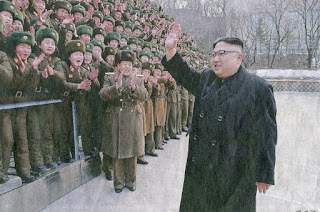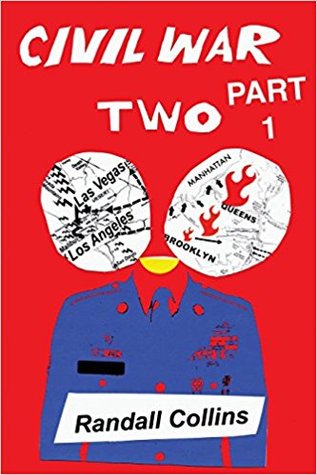What does a dictator look like in
action? There is a distinctive
pattern, but it is visible not so much on the dictator’s own face as in the
expressions of the persons surrounding him or her. (Since all the dictators
that I know about and have photos of are men, I will use the male pronoun.)
The dictator is the center of rapt
attention. It is compulsory to look at him, and dangerous to show any emotional
expression other than what the dictator is displaying. Faces surrounding a
dictator mirror his expressions, but in a strained and artificial way.
Let us examine a series of photos
of Kim Jong Un, the North Korean dictator.
Kim Jong Un smiles a lot for the
crowd, but that isn’t the striking thing. His smile is pallid and not very
warm, but the people around him are fervently smiling and applauding. They are
putting a lot of energy into it, trying to smile as hard as they can.
These are forced smiles. As
psychologist Paul Ekman has shown in detailed studies of the facial muscles
used in different kinds of emotions, smiles vary a great deal in intensity and
spontaneity. (For examples, see my blog: Mona Lisa is No Mystery forMicro-Sociology.)
Fake smiles can be easily
detected, as can the other emotions they are blended with. As we shall see,
faces around a dictator blend the required expression with give-away signs of
tension, anxiety, and fear.
It happens with all ranks. In the
following photos, Kim Jong Un’s rather perfunctory smiles are amplified by his
intently attentive generals, foot soldiers, and military women alike:
Conversely, when Kim Jong Un isn’t
smiling, nobody smiles. When he is serious, everyone looks serious. Surrounding
faces mirror his expression as best they can.
And mirror his body postures too:
Occasionally we see nervous eyes, like the man directly
behind Kim Jong Un, glancing sideways to monitor what
he is supposed to display:
Or the man who bites his lip,
peering forward to catch the dictator’s expression as he telephones an order:
The pattern is the same with the previous dictator, Kim Jong Un’s father, Kim Jong Il:
The most exaggerated
expression is the safest: Kim Jong Il’s funeral
Photos of Kim Jong Il’s funeral, after his death in December
2011, show extraordinarily demonstrative expressions of grief, among all social
groups:
Well, almost all social groups. In the following photo, the
well-dressed women of the North Korean elite show the most intense grief, as
they reach the top of the red carpet. Further back in the queue, postures are
more restrained, and the guards and attendants along the side are stolid and
unexpressive.
A notable exception is Kim Jong Un himself, who shows no
grief but looks a little worried.
The over-the-top expressions of
grief are confined to the North Koreans. Photos of foreign dignitaries at the
funeral show them somber and respectful, bowing politely but showing no strong
emotions, let alone such ostensibly heart-rending displays. These are not
normal behavior at East Asian funerals.
Compulsory Front-stage performance of loyalty
We have seen the pattern. People
around the dictator, and particular those of high rank, mirror his expressions
and re-broadcast them at even higher intensity. They put a lot of effort into
it, so that their expressions look forced and unnatural. They look
over-the-top. The dictator himself doesn’t look strained, but the people around
him do.
Their expressions are not merely
for the eyes of the dictator. He doesn’t, on the whole, appear to be giving
them too much attention. Their expressions are for each other, broadcasting the
message that they are buying into the show as strongly as possible. They are
always on-stage for each other, sending the message of loyalty to the dictator.
It is a competitive situation, to show who is most loyal of all. The competition is strongest among the
elite—those closest to the dictator—because these are the persons who pose the
greatest potential threat. Quite likely there is an atmosphere of suspicion
and denunciation, as jockeying for power and favor takes place by detecting
signs of disloyalty among his followers—or even just lack of enthusiasm. *
* A former student of mine, who
had been a teenage girl at the time of the Red Guards movement in China, told
me that the hardest thing about the omnipresent public demonstrations was
keeping up the tone of fervent enthusiasm. It was dangerous not to; it could
get you pilloried as one of the counter-revolutionaries. When I introduced this
sociology student to Goffman’s concepts of frontstage and backstage, she immediately
characterized the most onerous part of the Red Guards movement as the
compulsion to express extreme emotions that one didn’t really feel--you were always on stage.
This is why we see such extreme
expressions of grief at the dictator’s funeral—a time of most intense jockeying
for power in the succession.
The succession crisis of dictators
Even when there is a family
succession, a de facto hereditary dictatorship, there is tension. The oldest
son does not necessarily succeed (Kim Jong Un was the third son of Kim Jong
Il), since the father may weigh who is most competent at wielding power. Photos
of father and heir show a distinctive pattern:
Here we see Kim Il-sung, founder of the North Korean regime,
and his son Kim Jong Il. The son is mirroring the smile and body posture of his
father, although older man looks confident and at ease, the son more tense. We
see the same again in a photo of Kim Jong Il as dictator, with Kim Jong Un as
heir apparent:
The following photo, taken in the last year of Kim Jong Il’s
life, is revealing because of the elite audience watching the interaction
between father and son. Kim Jong
Un is leaning deferentially towards his father, showing the uncertainty and
touch of anxiety he often showed in his father’s presence. Faces of the onlookers who can see both
of them most clearly have a wary look. One man is pursing his lips to one side,
giving a distorted look to his face (Ekman notes that an asymmetrical face,
showing different expressions on different sides, is a sign of mixed or
conflicting emotions.) The
onlookers don’t quite know who they should be mirroring here:
Why close is dangerous
In a dictatorship where loyalty is always suspect and must
be constantly demonstrated, those nearest to power are the most dangerous. This
was illustrated within two years of Kim Jong Un’s formal succession. His uncle,
Jang Song-thaek, 40 years older than the young heir, acted as informal regent.
The following picture, taken during that early period, suggests guarded suspicion
between the two:
By September 2013, however, Kim Jong Un was leading the
public smiles, and his uncle was following along:
By December 2013, the uncle was arrested, tried, and
executed. Reportedly, he had plotted a coup. Or perhaps he just aroused
suspicion, by not giving off the right emotional displays. Soon after, the rest
of the uncle’s family apparently were executed too.
Since then, an older brother was killed. And the dictator is back to smiling,
surrounded by the wary, mirroring faces that characterize the dictatorship:
American tourists, too
The photo of
American tourist Otto Warmbier being brought into court for sentencing in March
2016, after two months in captivity, closely resembles the photo above of Kim
Jong Un's uncle Jang Song-thaek
being led into the same court in 2013, just before he was executed. In both cases, the arrestee shows the
same posture: hopeless downcast eyes, body slumping in extreme depression.
Undoubtedly they had been put under relentless psychological pressure to
confess, and probably physical torture.
Their offenses, at
least initially, were different: Jang Song-thaek was charged with staging a coup d'etat; Otto Warmbier with defacing or
attempting to steal a government propaganda poster from his hotel just before
he got on the plane. After Warmbier was released in a coma from which he never
recovered, a North Korean official said his punishment was for trying to
overthrow the regime.
Most likely, Otto
Warmbier, acting like an American college student on vacation, was trying to
collect a souvenir poster (the way
we used to take bullfight posters or beer coasters). But youthful pranks are not recognized in the official
culture of the North Korean dictatorship. Every expression is deadly serious in
its consequence, and every individual is under suspicion.
In such regimes,
there is no private life and no backstage fun and games. Disrespecting a symbol is taken as an
attack on the regime it symbolizes.
What can be done? That is a complicated political and military problem.
It would be an enormous step for the regime to loosen up, just to allow a space
for trivial matters.
Goodreads Book Giveaway
Civil War Two, Part 1
by Randall Collins
Giveaway ends May 24, 2018.
See the giveaway details at Goodreads.
























